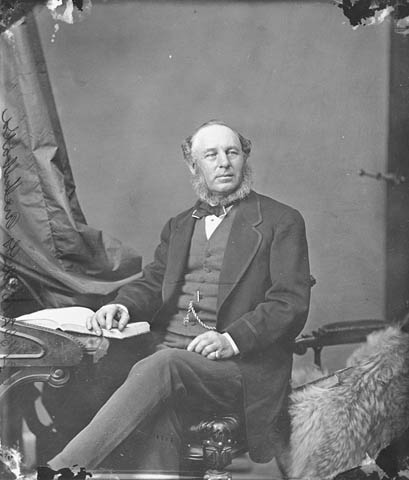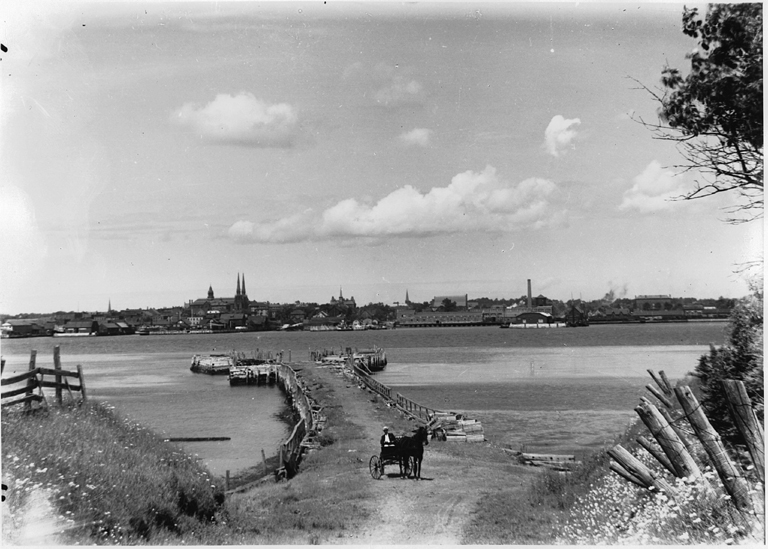|
Hillsborough River (Prince Edward Island)
The Hillsborough River, also known as the East River, is a Canadian river in northeastern Queens County, Prince Edward Island. History Battle at Port-la-Joye After the Siege of Louisbourg (1745) during King George's War, the New Englanders also captured Île Saint-Jean (modern Prince Edward Island). The New Englanders had a force of two warships and 200 soldiers stationed at Port-la-Joye.Havey. The French régime in Prince Edward Island, p. 119See book/ref> To regain Acadia, Jean-Baptiste Nicolas Roch de Ramezay was sent from Quebec to the region to join forces with the Duc d'Anville expedition. Upon arriving at Chignecto, he sent French officer Charles Deschamps de Boishébert et de Raffetot to Île Saint-Jean on reconnaissance to assess the size of the New England force. After Boishébert returned, Ramezay sent Joseph-Michel Legardeur de Croisille et de Montesson, along with over 500 men, 200 of whom were Mi'kmaq, to Port-la-Joye. In July, 1746, the battle happened nea ... [...More Info...] [...Related Items...] OR: [Wikipedia] [Google] [Baidu] |
Hants County
Hants County is an historical county and census division of Nova Scotia, Canada. Local government is provided by the West Hants Regional Municipality, and the Municipality of the District of East Hants. History Formation The county of Hants was established June 17, 1781, on territory taken from Kings County and consisted of the townships of Windsor, Falmouth and Newport. The name Hants is an old abbreviation for the English county of Hampshire, from the Old English name ''Hantescire''. In 1861, Hants County was divided for court sessional purposes into two districts named East Hants and West Hants. In 1879, the two districts were incorporated as district municipalities. In 2020, the Town of Windsor amalgamated with the District of West Hants to become the West Hants Regional Municipality. 18th century - origins Miꞌkmaq The Miꞌkmaq are the indigenous peoples who lived on these lands for centuries. In the course of their historical relationship with the Acadians, many ... [...More Info...] [...Related Items...] OR: [Wikipedia] [Google] [Baidu] |
Narrow-gauge Railway
A narrow-gauge railway (narrow-gauge railroad in the US) is a railway with a track gauge narrower than standard-gauge railway, standard . Most narrow-gauge railways are between and . Since narrow-gauge railways are usually built with Minimum railway curve radius, tighter curves, smaller structure gauges, and lighter rails, they can be less costly to build, equip, and operate than standard- or broad-gauge railways (particularly in mountainous or difficult terrain). Lower-cost narrow-gauge railways are often used in mountainous terrain, where engineering savings can be substantial. Lower-cost narrow-gauge railways are often built to serve industries as well as sparsely populated communities where the traffic potential would not justify the cost of a standard- or broad-gauge line. Narrow-gauge railways have specialised use in mines and other environments where a small structure gauge necessitates a small loading gauge. In some countries, narrow gauge is the standard; Japan, Indone ... [...More Info...] [...Related Items...] OR: [Wikipedia] [Google] [Baidu] |
Southport, Prince Edward Island
Southport is a community in Queens County, Prince Edward Island, Canada. Since April 1, 1995, when the ''Charlottetown Area Municipalities Act'' came into effect and created the town of Stratford, Southport has been part of Stratford. Notable residents *Betty Jean Brown Betty Jean Brown (born October 31, 1937) is a registered nurse and former political figure in Prince Edward Island. She represented 3rd Queens in the Legislative Assembly of Prince Edward Island from 1986 to 1993 as a Liberal. She was born Betty ..., registered nurse and political figure * George F. Dewar, physician and political figure References Communities in Queens County, Prince Edward Island Former community municipalities in Prince Edward Island {{PEI-geo-stub ... [...More Info...] [...Related Items...] OR: [Wikipedia] [Google] [Baidu] |
Prince Edward Island Railway
The Prince Edward Island Railway (PEIR) was a historic Canadian railway in Prince Edward Island (PEI). The railway ran tip-to-tip on the island, from Tignish in the west to Elmira in the east, with major spurs serving Borden-Carleton's train ferry dock, the capital in Charlottetown, Montague and Georgetown and the original eastern terminus at Souris. A major spur from Charlottetown served Murray Harbour on the south coast. Construction began in 1871 but costs almost bankrupted the government by the next year, a problem that helped pave PEI's entrance into Confederation. The work was picked up by the Canadian Government Railways and largely completed by the mid-1880s. The PEIR saw heavy use, especially during World War II, but like many railways saw declining use through the 1970s. The line officially closed on 31 December 1989 and the rails removed between 1990 and 1992, with the provincial government receiving a one-time payment of $200 million to upgrade the road network i ... [...More Info...] [...Related Items...] OR: [Wikipedia] [Google] [Baidu] |
Fathers Of Confederation
The Fathers of Confederation are the 36 people who attended at least one of the Charlottetown Conference of 1864 (23 attendees), the Quebec Conference of 1864 (33 attendees), and the London Conference of 1866 (16 attendees), preceding Canadian Confederation. Only eleven people attended all three conferences. Table of participation The following table lists the participants in the Charlottetown, Quebec, and London Conferences and their attendance at each stage. Group photographs Other possible claimants to title Four other individuals have been labelled as Fathers of Confederation. Hewitt Bernard, who was the recording secretary at the Charlottetown Conference, is considered by some to be a Father of Confederation. The leaders most responsible for bringing three specific provinces into Confederation after 1867 are also referred to as Fathers of Confederation. * The provisional government established by Louis Riel ultimately negotiated the terms under which Manitoba entered t ... [...More Info...] [...Related Items...] OR: [Wikipedia] [Google] [Baidu] |
Canadian Heritage Rivers System
The Canadian Heritage Rivers System (CHRS; french: Le réseau de rivières du patrimoine canadien) is a joint program administered by the federal, provincial and territorial governments to conserve and protect the best examples of Canada's river heritage, to give them national recognition, and to encourage the public to enjoy and appreciate them. It is a cooperative program of the governments of Canada, nine provinces, and the three territories. A 14-member national board, created under the Parks Canada Agency Act, administers the program and approves the designation of specific rivers. History The Canadian Heritage Rivers System was established in 1984. The first Canadian Heritage River was the French River in Ontario, designated in 1986. By 1996 there were 29 designated rivers. Quebec withdrew its participation in 2006. There are currently 39 designated and three nominated rivers; with rivers designated in every province and territory except for Quebec. Designated rivers The ... [...More Info...] [...Related Items...] OR: [Wikipedia] [Google] [Baidu] |
Charlottetown
Charlottetown is the capital and largest city of the Canadian province of Prince Edward Island, and the county seat of Queens County. Named after Queen Charlotte, Charlottetown was an unincorporated town until it was incorporated as a city in 1855. It was the site of the famous Charlottetown Conference in 1864, the first gathering of Canadian and Maritime statesmen to discuss the proposed Maritime Union. This conference led, instead, to the union of British North American colonies in 1867, which was the beginning of the Canadian confederation. PEI, however, did not join Confederation until 1873. From this, the city adopted as its motto ''Cunabula Foederis'', "Birthplace of Confederation". The population of Charlottetown is estimated to be 40,500 (2022); this forms the centre of a census agglomeration of 83,063 (2021), which is roughly half of the province's population (160,302). History Early history (1720–1900) The first European settlers in the area were French; perso ... [...More Info...] [...Related Items...] OR: [Wikipedia] [Google] [Baidu] |
Mount Stewart, Prince Edward Island
Mount Stewart is a rural municipality in Prince Edward Island, Canada. It is located in the northeastern part of Queens County, at the head of the once-navigable portion of the Hillsborough River at the point where the river begins to narrow significantly. Mount Stewart had a population of 226 at the time of the 2021 Census. The community played an important role in the province's early transportation history, being the site of a bridge over the river along the route between the capital at Charlottetown and the shire town of Kings County at Georgetown. History In the early 1870s, the Prince Edward Island Railway ran its mainline between both communities through Mount Stewart. If any one wanted to travel to Georgetown or Souris from Charlottetown, they would have to come through or make a stop at Mount Stewart. Mount Stewart also came to be referred to as Mount Stewart Junction after the PEIR built a line northeast to Morell and Souris. During the 1930s, the community b ... [...More Info...] [...Related Items...] OR: [Wikipedia] [Google] [Baidu] |
Estuary
An estuary is a partially enclosed coastal body of brackish water with one or more rivers or streams flowing into it, and with a free connection to the open sea. Estuaries form a transition zone between river environments and maritime environments and are an example of an ecotone. Estuaries are subject both to marine influences such as tides, waves, and the influx of saline water, and to fluvial influences such as flows of freshwater and sediment. The mixing of seawater and freshwater provides high levels of nutrients both in the water column and in sediment, making estuaries among the most productive natural habitats in the world. Most existing estuaries formed during the Holocene epoch with the flooding of river-eroded or glacially scoured valleys when the sea level began to rise about 10,000–12,000 years ago. Estuaries are typically classified according to their geomorphological features or to water-circulation patterns. They can have many different names, such as bays, ... [...More Info...] [...Related Items...] OR: [Wikipedia] [Google] [Baidu] |
Hillsborough River Bridge
The Hillsborough River Bridge is a bridge crossing the Hillsborough River estuary between Charlottetown and Stratford in Queens County, Prince Edward Island. The current road bridge, built in 1962, replaced a 1905 rail bridge crossing the same span which was known by the same name. The first bridge was built by the Prince Edward Island Railway to complete a rail line from Charlottetown to Murray River. The single-lane bridge opened in 1905, and incorporated iron spans from two bridges in Miramichi, New Brunswick built about 30 years earlier. As rail service in the province was converted to standard gauge and heavier service, use of the bridge declined until it was deemed unsafe for all traffic in the 1950s. As the Trans-Canada Highway project was planned in the 1950s, improving the crossing of the Hillsborough River was deemed essential. A new, improved 2-lane road bridge was built immediately upstream of the old rail bridge, opening in 1962. The bridge was widened to carry 4 l ... [...More Info...] [...Related Items...] OR: [Wikipedia] [Google] [Baidu] |
Halifax, Nova Scotia
Halifax is the capital and largest municipality of the Canadian province of Nova Scotia, and the largest municipality in Atlantic Canada. As of the 2021 Census, the municipal population was 439,819, with 348,634 people in its urban area. The regional municipality consists of four former municipalities that were amalgamated in 1996: Halifax, Dartmouth, Bedford, and Halifax County. Halifax is a major economic centre in Atlantic Canada, with a large concentration of government services and private sector companies. Major employers and economic generators include the Department of National Defence, Dalhousie University, Nova Scotia Health Authority, Saint Mary's University, the Halifax Shipyard, various levels of government, and the Port of Halifax. Agriculture, fishing, mining, forestry, and natural gas extraction are major resource industries found in the rural areas of the municipality. History Halifax is located within ''Miꞌkmaꞌki'' the traditional ancestral lands ... [...More Info...] [...Related Items...] OR: [Wikipedia] [Google] [Baidu] |
.jpg)






